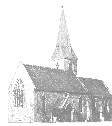
 |
CHAPTER 16. RETAIL IN CRANHAM |
The early shops in Cranham were clustered around the junction of Moor Lane with Front Lane and to date this is still the retail 'heart' of Cranham village. The early shops in the 1950's provided the basic essentials, with shops such as butchers, grocers, greengrocers and hardware being represented. At this stage there was no bakers and crucially (for young mothers) no pharmacist; those needing prescription medicines faced a long walk into Upminster!
The old farm still remained opposite the end of Moor Lane and north of Ingrebourne Gardens was still scrub land. The Plough public house was still located north of the shops (about 300 yards up on the right hand side.)
Click here to see map of circa. 1953
Virtually all of the development of the shops at the centre of Cranham took place over the next ten years. The approximate order of construction is given below (with the list numbers corresponding to those on the map
Click here to see the map with above details
The map details also include the fate of many of the shops from 1970 onwards. As with many suburban town centres, the mix of shops has changed over the last twenty years, with the demise of the 'staple food shops' such as butchers, bakers etc. as the growth of out-of-town supermarkets has stolen their markets. In their place has grown the more specialist shops catering for furnishings and home improvements. There is no doubt that this has changed the character of the village although the parking problems seem to remain unchanged!
The other main shopping area in Cranham are those at the eastern end of Avon Road, just under half a mile north of the main village shops. These were all erected at the same time as the main Avon Road housing estate in 1958, along with the Golden Crane public house. We know less of these shops than those in the village, but their current occupancy and, where known, their previous history is documented in the Avon road shops map. (Thanks to Mr Mills of Cranham for his contribution to this part of the site.)
Cranham has four public houses within its parish boundary. 'The Plough' is situated amongst the main centre shops (the map shows it's location). 'The Golden Crane' is situated at the end of the parade of shops in Avon road. (See avon road map for exact location.) Those living in the south of Cranham, in the 'cathedral city' estate of houses' to the south of the railway are lucky in having a choice of two pubs within a space of two hundred metres, the 'Thatched House' and the 'Jobbers Rest'. (The principal authors can vouch for the quality of ales sold in all four establishments!) Follow the link for photographs taken in 1999.